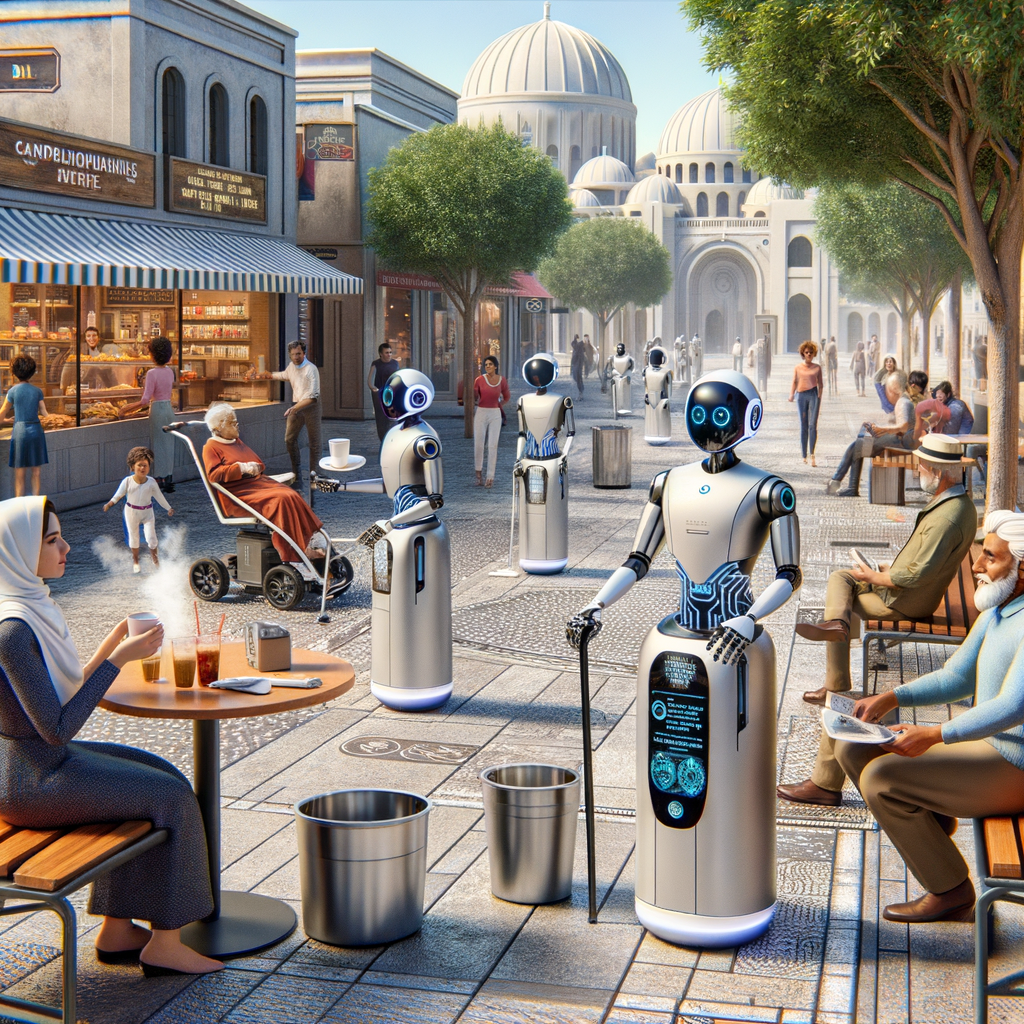“AI Revolution: Robots, Ethics, and Content Innovation in 2025”

AI Robots Step Beyond Factories into Public Domains
The year 2025 marks a transformative phase where AI-powered robots are moving beyond factory floors to become indispensable in public spaces. Equipped with generative AI (GenAI), these robots can now handle tasks traditionally requiring human intervention, such as cooking, cleaning, interacting with customers, and much more. However, this evolution is not without its own set of challenges.
The Transition to Public Interaction
- Expanding Capabilities: Robots are no longer confined to warehouses and industrial settings. They’ve been deployed in museums, retail spaces, and even restaurants to assist with tasks like cleaning and engaging with visitors.
- Boosting Interactions with GenAI: Generative AI provides robots the ability to understand natural language, navigate obstacles, and perform nuanced planning tasks. This makes human-robot collaboration smoother and more intuitive.
- Investment in AI Robotics: Investors are optimistic about the future of AI robotics, as evidenced by the $12.8 billion in funding the industry received in 2024. This surge highlights the confidence in AI-driven automation.
Challenges and Limitations
- Technical Hurdles: Despite advancements, robots continue to face issues related to dexterity, navigating elevators, and managing group conversations. These shortcomings indicate areas ripe for development.
- Real-World Applications: In hospitals, robots are used to carry towels. Similarly, restaurants have begun experimenting with robots for food preparation—a cost-effective and efficient solution.
What Lies Ahead?
Industry experts foresee 2025 as a potential tipping point for AI robotics, with advancements making these machines more secure and capable. As public spaces become increasingly automated, the integration of smarter AI will ensure that robots can better meet the demands of diverse environments.
Conclusion
AI robots are steadily moving into public life, combining automation with human-like features to augment productivity and efficiency. While technical challenges persist, continued investment and innovation could make 2025 a landmark year for AI in public spaces.
AI Ethics Take Center Stage: The Hinton-Musk vs. OpenAI Debate
A heated battle is taking shape within the AI community as Geoffrey Hinton, often referred to as the “godfather of AI,” lends his support to Elon Musk’s lawsuit against OpenAI. Key concerns include OpenAI’s transition from its nonprofit roots to a for-profit model, prompting ethical, safety, and transparency debates.
The Key Players and Their Concerns
- Geoffrey Hinton: A pioneer in neural networks, Hinton has openly criticized OpenAI’s pivot to a profit-focused model, arguing that it undermines its initial mission of prioritizing AI safety.
- Elon Musk’s Legal Push: Musk, a co-founder of OpenAI, refiled a lawsuit alleging that the company now prioritizes profit over safety and transparency, citing its multi-billion-dollar valuation and partnership with Microsoft.
Industry and Ethical Implications
- Accountability Concerns: Critics, including advocacy groups like Encode, argue that OpenAI’s actions could set dangerous precedents for AI governance.
- Safety vs. Profits: OpenAI’s meteoric rise in valuation, now at $157 billion, raises fears that financial incentives could overshadow AI ethics and safety commitments.
Conclusion
The lawsuit initiated by Musk and supported by Hinton isn’t just a legal battle—it’s a significant moment for AI governance. Questions about accountability and ethics in AI development will likely reshape regulatory frameworks moving forward.
Actionable Insights: Writing SEO-Optimized, Authoritative Content
AI tools like ChatGPT are redefining content creation by guiding users to develop engaging and SEO-friendly articles that boost organic reach. Here’s a step-by-step framework to craft high-quality content.
Key Steps in Content Development
- Research and Topic Analysis: Conduct thorough research on trending topics, audience needs, and industry pain points.
- Outline Creation: Use logical frameworks to organize content, ensuring a smooth flow from introduction to conclusion.
- Headline Optimization: Craft eye-catching titles and headings that grab attention while improving readability.
- Content Writing: Incorporate examples, statistics, and expert opinions; keep language direct and impactful.
- SEO Integration: Utilize relevant keywords, meta descriptions, and internal/external links to enhance search rankings.
- Compelling Call-to-Action (CTA): End with a strong, actionable conclusion to engage readers.
Takeaway
Use tools like ChatGPT to automate and streamline your content strategy. By weaving SEO best practices with engaging narratives, you’ll establish thought leadership while driving considerable traffic to your platform.
Trending Updates in AI
- Alibaba reduces prices on its Qwen-VL AI model by 85%, focusing on enterprise adoption over consumer chatbots.
- Brazil’s Carecode employs AI agents to streamline healthcare costs via automated scheduling.
- Nvidia finalizes a $700M acquisition of AI startup Run:ai, intending to open-source its software.
Stay informed, stay ahead of the curve.
Relevant Hashtags
#AI #Robotics #ArtificialIntelligence #OpenAI #AIethics #GenerativeAI #SEO #DigitalTransformation #Technology #Innovation